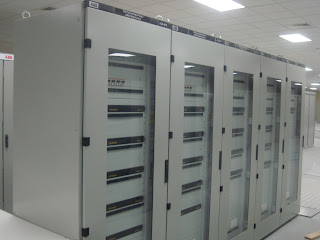Ferroresonance is a phenomena appears in the system voltage in the non linear Inductance circuit , capacitance load circuit after following transient disturbances.
Transient over voltage in the system (Variable Voltage in the system)
Lighting over voltage in the system
Temporary fault or switching operation of CB , DS or fault clearing
Transformer energization.
The voltage jump from one stable state to another ( Oscillation ) is highly depend on initial conditions of the above mention circuit. ( residual flux in the transformer or non linear load , capacitance, switching instant ).
The effect of the Ferroresonance is,
1.Sustained Over voltage and Over current with waveform distortion,
2.Loud noise,
3. Malfunction of protection relays,
4.Over heating
5.Electrical equipment damage,
6.Insulation breakdown.
Once the Ferroresonance has appeared, the system keeps working under Ferroresonance situation until the source fail to give the energy to maintain it.
FERRORESONANCE IN VOLTAGE TRANSFORMER
Voltage transformers are devices particularly prone to ferroresonance on account of its nonlinear character and operating characteristics, because they are designed to work under conditions similar to no-load ones.
On the one hand, inductive voltage transformers are even more susceptible to ferroresonance, since they have a higher inductive character and, consequently, they need a lower capacitance to form the ferroresonant circuit . This tendency of inductive transformers to be prone to ferroresonance becomes more important when operating in isolated grounded systems or when feeded by circuits that include circuit breakers with grading capacitances. On the other hand, the design of capacitive voltage transformers includes a capacitive divider that increases their tendency to ferroresonance occurrence.
The controlling of ferroresonance in primary side is very difficult since the controlling of causes of ferroresonance. But ferroresonance effect can control in VT secondary voltage and can avoid the damaging the secondary equipments ( meters, relays) malfunctions of protective relays .
1.
Inductive Voltage Transformers
To control these ferroresonance oscillations , a damping circuit is insert in the transformer’s
open-delta secondary (tertiary) winding.
Damping circuit in the transformer’s open-delta secondary
(tertiary) winding
A damping circuit formed by a resistor connected in series with an LC filter or a saturable inductor.
The performance of LC filters is used to damp the ferroresonant oscillation at frequencies different from the
fundamental one.
Basic circuits for ferroresonance suppression
In this circuit the resistor is continiously connected in in the seconday circuit and more heat take places. And the other hand , the use of a saturable inductor connected in series with a resistor makes the damping circuit adequate for every ferroresonant oscillation, since its performance with regard to saturation does not depend on the frequency content. This way, the inductor works as a magnetic switch: when the ferroresonant phenomenon appears, the inductor gets saturated, giving way to the reduction of its impedance and inserting the series-connected resistor that allows damping the ferroresonance.
3.2. Capacitive Voltage Transformers
These kinds of transformers usually include a ferroresonance suppression system . Althoughthe aim of this system is to damp effectively the ferroresonance phenomenon, its inclusion may affect considerably the transient response of the transformer, causing misoperation of protective relays and associated systems.
Nowadays, there are mainly two types of ferroresonance suppression circuits in capacitive voltage transformers:
Active Ferroresonance Suppression Circuits (AFSC), base on a series-parallel RLC filter, and Passive Ferroresonance Suppression Circuits (PFSC), based on a saturable inductor in series with a damping resistance. AFSC are more effective in damping the ferroresonant oscillations than PFSC, although its influence on the transient response of the transformer is higher. Both systems usually incorporate surge protection devices. Figure shows the typical elements included in the design of a ferroresonance suppression circuit.
More details about Ferroresonance in Voltage Transformer DOWNLOAD






























2.jpg)


















